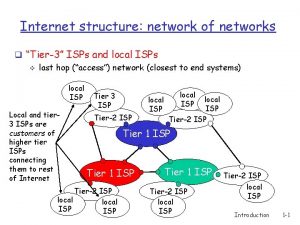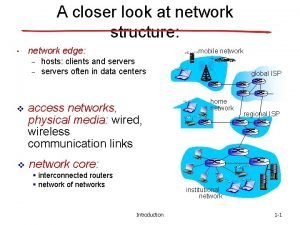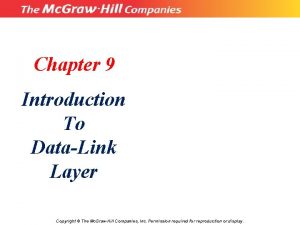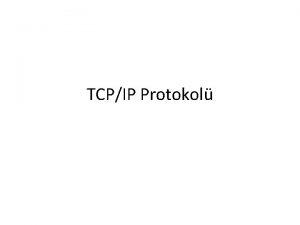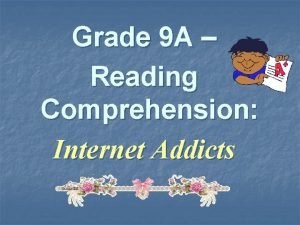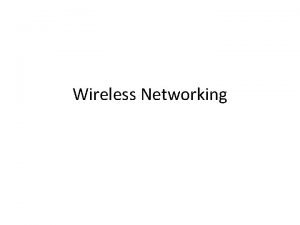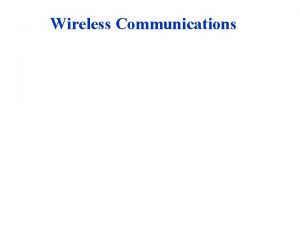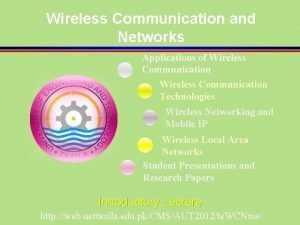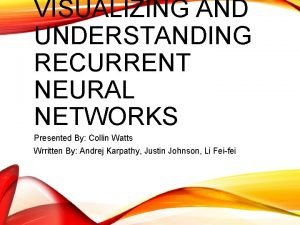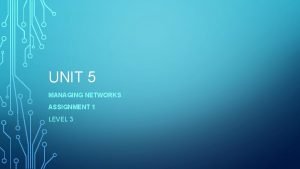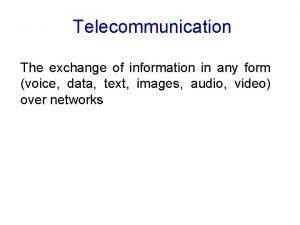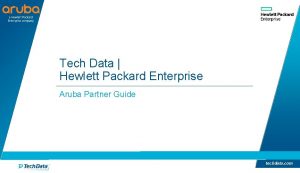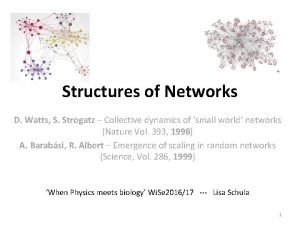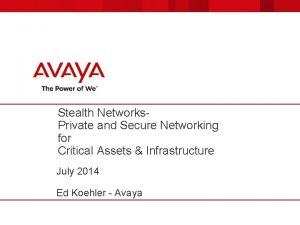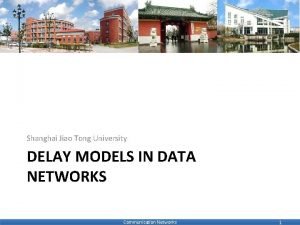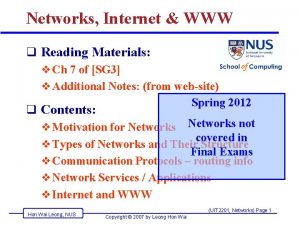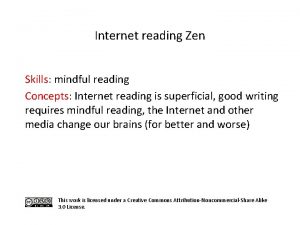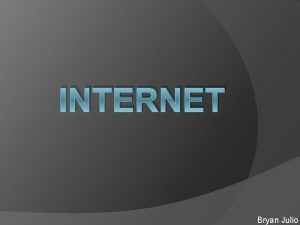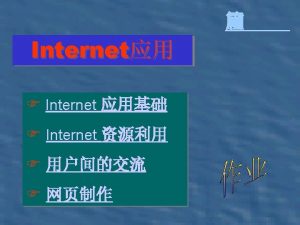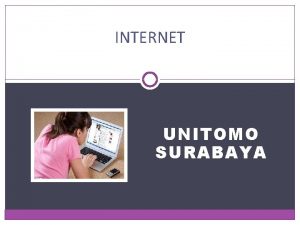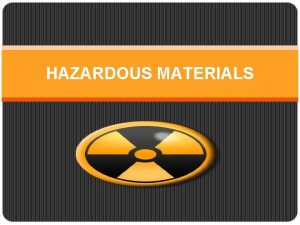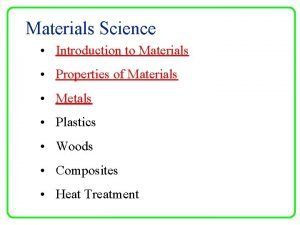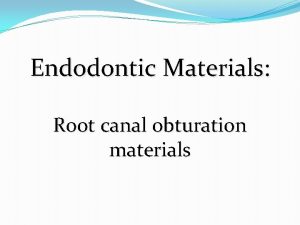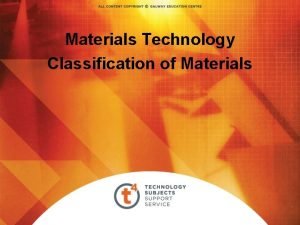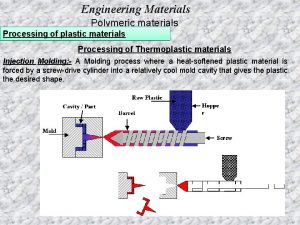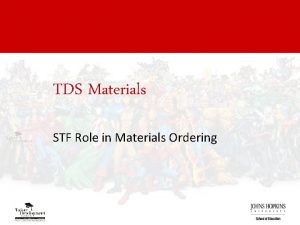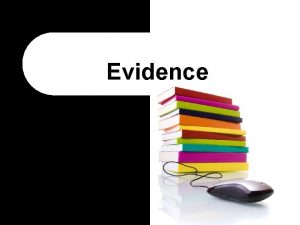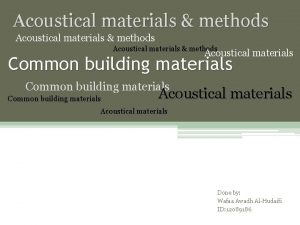Networks Internet WWW q Reading Materials v Ch
![Networks, Internet & WWW q Reading Materials: v Ch 7 of [SG 3] v Networks, Internet & WWW q Reading Materials: v Ch 7 of [SG 3] v](https://slidetodoc.com/presentation_image_h/85b57e4841031846395e4510f8176b65/image-1.jpg)












































- Slides: 45
![Networks Internet WWW q Reading Materials v Ch 7 of SG 3 v Networks, Internet & WWW q Reading Materials: v Ch 7 of [SG 3] v](https://slidetodoc.com/presentation_image_h/85b57e4841031846395e4510f8176b65/image-1.jpg)
Networks, Internet & WWW q Reading Materials: v Ch 7 of [SG 3] v Additional Notes: (from web-site) q Contents: v Motivation for Networks v Types of Networks and Their Structure v Communication Protocols – routing info v Network Services / Applications v Internet and WWW Hon Wai Leong, NUS (UIT 2201, Networks) Page 1 Copyright © 2007 by Leong Hon Wai

Networks, Internet, WWW q Context so far… v Use algorithm to solve problem v Database used to organize massive data v Algorithms implemented using hardware Educational Goals for this Chapter: q The computer as a tool for v Communication and Collaboration v Information Sharing v Resource Sharing v Shared Services Hon Wai Leong, NUS (UIT 2201, Networks) Page 2 Copyright © 2007 by Leong Hon Wai

Introduction to Computer Network q What is a Computer Network v Computers connected together v Why: Share information and resources v What kind of information u data files (pictures, videos, audio), programs u movies, tv and radio signals v What kind of services u a shared printer u a shared software application Hon Wai Leong, NUS (UIT 2201, Networks) Page 3 Copyright © 2007 by Leong Hon Wai

Basic Networking Concepts q A Computer Network v A set of independent computer systems u connected by telecommunication links v Purpose: u sharing information and resources v Nodes, hosts, or end systems u individual computers on a network Hon Wai Leong, NUS (UIT 2201, Networks) Page 4 Copyright © 2007 by Leong Hon Wai

The Basic Communication Link q Dial-up telephone line, v A circuit is temporarily established ubetween caller and callee v Analog medium (analog signals) v Requires modem at both ends to transmit information produced by a computer u. Computer produces digital information Hon Wai Leong, NUS (UIT 2201, Networks) Page 5 Copyright © 2007 by Leong Hon Wai

Analog vs Digital Signals Figure 7. 1 Two Forms of Information Representation Hon Wai Leong, NUS (UIT 2201, Networks) Page 6 Copyright © 2007 by Leong Hon Wai

Analog Digital Conversion Figure 7. 2: Modulation of a Carrier to Encode Binary Information Hon Wai Leong, NUS (UIT 2201, Networks) Page 7 Copyright © 2007 by Leong Hon Wai

The Communication Link (cont…) q Dial-up phone links v Transmission rate: 56 Kbps q Broadband v Transmission rate: > 256 Kbps Home Use: * DSL * Cable modem Hon Wai Leong, NUS Office & Commercial Use: * Ethernet * Fast Ethernet * Gigabit Ethernet (UIT 2201, Networks) Page 8 Copyright © 2007 by Leong Hon Wai

Comparison of Transmission Speed Figure 7. 3: Transmission Time of an Image at Different Transmission Speeds Hon Wai Leong, NUS (UIT 2201, Networks) Page 9 Copyright © 2007 by Leong Hon Wai

Communication Links (continued) q Wireless Data Communication v Uses radio-wave, microwave, infrared v Enables “mobile computing” v Two types: u Wireless Local Access Network u Wireless Wide-area Access Network Hon Wai Leong, NUS (UIT 2201, Networks) Page 10 Copyright © 2007 by Leong Hon Wai

Local Area Networks q Local Area Networks (LAN) v Used to connects computers in a small area (say, in a building) q Common LAN topologies Hon Wai Leong, NUS (UIT 2201, Networks) Page 11 Copyright © 2007 by Leong Hon Wai

Local Area Networks (cont…) q Most commonly wired by Ethernet v Using bus topology v Two ways to wire-up an Ethernet LAN Hub Shared Cable Hon Wai Leong, NUS (UIT 2201, Networks) Page 12 Copyright © 2007 by Leong Hon Wai

Wide Area Networks q To connect across town, country, ocean Figure 7. 7: Typical Structure of a Wide Area Network Hon Wai Leong, NUS (UIT 2201, Networks) Page 13 Copyright © 2007 by Leong Hon Wai

Wide Area Networks q To connect across town, country, ocean q Dedicated point-to-point lines q Expensive. v By major service providers (SP) v Users buy services from SP q Uses different protocol: v Store-and-forward, packet-switched tech. Hon Wai Leong, NUS (UIT 2201, Networks) Page 14 Copyright © 2007 by Leong Hon Wai

Hon Wai Leong, NUS (UIT 2201, Networks) Page 15 Copyright © 2007 by Leong Hon Wai

Overall Structure of the Internet q All real-world networks, including the Internet, are a mix of LANs and WANs v Example: A company or a college u. One or more LANs connecting its local computers u. Individual LANs interconnected into a wide-area company network Hon Wai Leong, NUS (UIT 2201, Networks) Page 16 Copyright © 2007 by Leong Hon Wai

Structure of Large Network q Large networks contains hybrid… Figure 7. 8(a): Structure of a Typical Company Network Hon Wai Leong, NUS (UIT 2201, Networks) Page 17 Copyright © 2007 by Leong Hon Wai

Overall Structure of the Internet (cont…) q Internet Service Provider (ISP) v A wide-area network v Provides a pathway from a specific network to other networks, or from an individual’s computer to other networks q ISPs are hierarchical v Interconnect to each other in multiple layers to provide greater geographical coverage Hon Wai Leong, NUS (UIT 2201, Networks) Page 18 Copyright © 2007 by Leong Hon Wai

Figure 7. 8(b) Structure of a Network Using an ISP Hon Wai Leong, NUS (UIT 2201, Networks) Page 19 Copyright © 2007 by Leong Hon Wai

Figure 7. 8(c) Hierarchy of Internet Service Providers Hon Wai Leong, NUS (UIT 2201, Networks) Page 20 Copyright © 2007 by Leong Hon Wai

Overall Structure of the Internet q Internet v A huge interconnected “network of networks” v Includes nodes, LANs, WANs, bridges, routers, and multiple levels of ISPs v Early 2003 u 170 million nodes (hosts) u. Hundreds of thousands of separate networks located in over 225 countries Hon Wai Leong, NUS (UIT 2201, Networks) Page 21 Copyright © 2007 by Leong Hon Wai

Communication Protocols q A protocol v A mutually agreed upon set of rules, conventions, and agreements for the efficient and orderly exchange of information q TCP/IP v The Internet protocol hierarchy v Governs the operation of the Internet v Five layers Hon Wai Leong, NUS (UIT 2201, Networks) Page 22 Copyright © 2007 by Leong Hon Wai

Figure 7. 10 The Five-Layer TCP/IP Internet Protocol Hierarchy Hon Wai Leong, NUS (UIT 2201, Networks) Page 23 Copyright © 2007 by Leong Hon Wai

Physical Layer q Protocols govern the exchange of binary digits across a physical communication channel q Goal: Create a bit pipe between two computers Hon Wai Leong, NUS (UIT 2201, Networks) Page 24 Copyright © 2007 by Leong Hon Wai

Data Link Layer q Protocols carry out v Error handling v Framing q Creates an error-free message pipe q Composed of two services v Layer 2 a: Medium access control v Layer 2 b: Logical link control Hon Wai Leong, NUS (UIT 2201, Networks) Page 25 Copyright © 2007 by Leong Hon Wai

Data Link Layer (continued) q Medium access control protocols v Determine how to arbitrate ownership of a shared line when multiple nodes want to send at the same time q Logical link control protocols v Ensure that a message traveling across a channel from source to destination arrives correctly Hon Wai Leong, NUS (UIT 2201, Networks) Page 26 Copyright © 2007 by Leong Hon Wai

Network Layer q Delivers a message from the site where it was created to its ultimate destination q Critical responsibilities v Create a universal addressing scheme for all network nodes v Deliver messages between any two nodes in the network Hon Wai Leong, NUS (UIT 2201, Networks) Page 27 Copyright © 2007 by Leong Hon Wai

Network Layer (continued) q Provides a true network delivery service v Messages are delivered between any two nodes in the network, regardless of where they are located q IP (Internet Protocol) layer v Network layer in the Internet Hon Wai Leong, NUS (UIT 2201, Networks) Page 28 Copyright © 2007 by Leong Hon Wai

Transport Layer q Provides a high-quality, error-free, order- preserving, end-to-end delivery service q TCP (Transport Control Protocol) v Primary transport protocol on the Internet v Requires the source and destination programs to initially establish a connection Hon Wai Leong, NUS (UIT 2201, Networks) Page 29 Copyright © 2007 by Leong Hon Wai

Figure 7. 15 Logical View of a TCP Connection Hon Wai Leong, NUS (UIT 2201, Networks) Page 30 Copyright © 2007 by Leong Hon Wai

Application Layer q Implements the end-user services provided by a network q There are many application protocols v HTTP v SMTP v POP 3 v IMAP v FTP Hon Wai Leong, NUS (UIT 2201, Networks) Page 31 Copyright © 2007 by Leong Hon Wai

Figure 7. 16 Some Popular Application Protocols on the Internet Hon Wai Leong, NUS (UIT 2201, Networks) Page 32 Copyright © 2007 by Leong Hon Wai

Application Layer (continued) q Uniform Resource Locator (URL) v A symbolic string that identifies a Web page v Form protocol: //host address/page v The most common Web page format is hypertext information u. Accessed using the HTTP protocol Hon Wai Leong, NUS (UIT 2201, Networks) Page 33 Copyright © 2007 by Leong Hon Wai

Network Services and Benefits q Services offered by computer networks v Electronic mail (email) v Bulletin boards v News groups v Chat rooms v Resource sharing u. Physical resources u. Logical resources Hon Wai Leong, NUS (UIT 2201, Networks) Page 34 Copyright © 2007 by Leong Hon Wai

Network Services and Benefits (continued) q Services offered by computer networks v Client-server computing v Information sharing v Information utility v Electronic commerce (e-commerce) Hon Wai Leong, NUS (UIT 2201, Networks) Page 35 Copyright © 2007 by Leong Hon Wai

A Brief History of the Internet and the World Wide Web: The Internet q August 1962: First proposal for building a computer network v Made by J. C. R. Licklider of MIT q ARPANET v Built by the Advanced Research Projects Agency (ARPA) in the 1960 s v Grew quickly during the early 1970 s Hon Wai Leong, NUS (UIT 2201, Networks) Page 36 Copyright © 2007 by Leong Hon Wai

The Internet (continued) q NSFNet: A national network built by the National Science Foundation (NSF) q October 24, 1995: Formal acceptance of the term Internet q Internet service providers start offering Internet access once provided by the ARPANET and NSFNet Hon Wai Leong, NUS (UIT 2201, Networks) Page 37 Copyright © 2007 by Leong Hon Wai

Figure 7. 20 State of Networking in the Late 1980 s Hon Wai Leong, NUS (UIT 2201, Networks) Page 38 Copyright © 2007 by Leong Hon Wai

The World Wide Web q Development completed in May 1991 q Designed and built by Tim Berners-Lee q Components v Hypertext u. A collection of documents interconnected by pointers called links v URL (Uniform Resource Locator) u. The worldwide identification of a Web page located on a specific host computer Hon Wai Leong, NUS (UIT 2201, Networks) Page 39 Copyright © 2007 by Leong Hon Wai

Figure 7. 21 Hypertext Documents Hon Wai Leong, NUS (UIT 2201, Networks) Page 40 Copyright © 2007 by Leong Hon Wai

WWW – web-pages q Web-pages are documents v similar to any other document, but v written in special “web-languages” uhtml (hypertext markup language) uxml (extensible markup language) v Allows text, pictures, formatting, etc q More sophisticated web-pages v Dynamic pages (dhtml) v Allows “programming” u. Pages with forms, questionnaires, etc u. Languages: cgi, perl, jsp, asp, etc… Hon Wai Leong, NUS (UIT 2201, Networks) Page 41 Copyright © 2007 by Leong Hon Wai

WWW – continued… q Tools for Creating Web-Pages v Back to basics (eg: UIT 2201 pages) v Frontpage, Dreamweaver, etc q Web-Sites v Individual Servers v Web-Hosting Servers q Web Applications v Forms, registration, etc v ASP (Application Service Providers) Hon Wai Leong, NUS (UIT 2201, Networks) Page 42 Copyright © 2007 by Leong Hon Wai

Summary q Computer network: A set of independent computer systems connected by telecommunication links q Options for transmitting data on a network: Dial-up telephone lines, DSL, cable modem, Ethernet, Fast Ethernet q Types of networks: Local area network (LAN) and wide area network (WAN) Hon Wai Leong, NUS (UIT 2201, Networks) Page 43 Copyright © 2007 by Leong Hon Wai

Summary (continued) q The Internet is a huge interconnected "network of networks" q TCP/IP is the Internet protocol hierarchy, composed of five layers: physical, data link, network, transport, and application q The World Wide Web is an information system based on the concept of hypertext Hon Wai Leong, NUS (UIT 2201, Networks) Page 44 Copyright © 2007 by Leong Hon Wai

Thank you. Hon Wai Leong, NUS (UIT 2201, Networks) Page 45 Copyright © 2007 by Leong Hon Wai
 Pre reading while reading and post reading activities
Pre reading while reading and post reading activities Datagram networks and virtual circuit networks
Datagram networks and virtual circuit networks Basestore iptv
Basestore iptv Internet transport protocol in computer networks
Internet transport protocol in computer networks Internet structure network of networks
Internet structure network of networks Internet structure network of networks
Internet structure network of networks Computer networks and internets with internet applications
Computer networks and internets with internet applications Which type of address is this: a3:34:45:11:92:f1
Which type of address is this: a3:34:45:11:92:f1 Osi vs tcp/ip
Osi vs tcp/ip Favourite cars
Favourite cars What is the useful and harmful
What is the useful and harmful Natural materials and man made materials
Natural materials and man made materials Differentiate adopting materials and adapting materials
Differentiate adopting materials and adapting materials Direct materials budget with multiple materials
Direct materials budget with multiple materials What is internet
What is internet What reading materials do you prefer
What reading materials do you prefer Efl reading materials
Efl reading materials Are you an internet addict reading comprehension
Are you an internet addict reading comprehension St. louis
St. louis What are the aims of teaching reading?
What are the aims of teaching reading? Types of readers
Types of readers Reading strategies edb
Reading strategies edb Why critical reading is an active process of discovery
Why critical reading is an active process of discovery What is extensive reading
What is extensive reading What is intensive reading
What is intensive reading Characteristics of intensive reading
Characteristics of intensive reading Wireless network definition
Wireless network definition Andrea goldsmith wireless communications
Andrea goldsmith wireless communications Constrained nodes and constrained networks
Constrained nodes and constrained networks Visualizing and understanding recurrent networks
Visualizing and understanding recurrent networks Visualizing and understanding convolutional networks
Visualizing and understanding convolutional networks Vc bound
Vc bound Unit 5 managing networks
Unit 5 managing networks Crc in computer networks
Crc in computer networks Crc in computer networks
Crc in computer networks Traffic management in computer networks
Traffic management in computer networks Speed of a computer
Speed of a computer What is optimality principle in computer networks
What is optimality principle in computer networks Neural pruning ib psychology
Neural pruning ib psychology Types of telecommunication networks
Types of telecommunication networks Aruba networks partner portal
Aruba networks partner portal Audio super resolution using neural networks
Audio super resolution using neural networks Collective dynamics of small world networks
Collective dynamics of small world networks Stealth networks
Stealth networks Snmp supports which formatted protocol
Snmp supports which formatted protocol Delay models in data networks
Delay models in data networks




